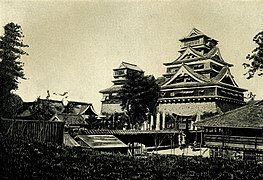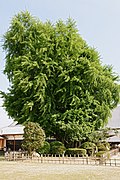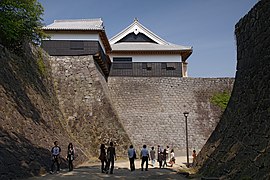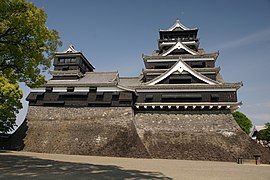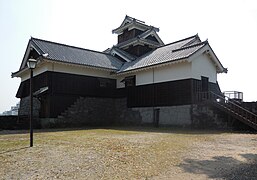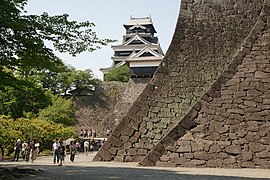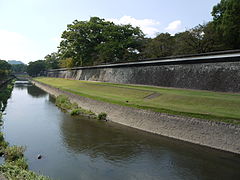Kumamoto Castle
| Kumamoto-jō | ||
|---|---|---|
|
Castle tower of the castle |
||
| Alternative name (s): | Ginkgo Castle | |
| Creation time : | 1601-1607 | |
| Castle type : | Hirayamajiro (hill castle) | |
| Conservation status: | partially preserved | |
| Place: | Kumamoto | |
| Geographical location | 32 ° 48 '21.8 " N , 130 ° 42' 21.5" E | |
|
|
||
The Kumamoto Castle ( Japanese 熊 本 城 Kumamoto-jō ) is located in the city of Kumamoto in Japan and was built at the beginning of the Edo period under Katō Kiyomasa ( 加藤 清正 ) from 1601 to 1607. It counts next to the castle Matsumoto and the castle Himeji to the Nihon sanmeijō ( 日本 三 名城 , dt. "Three important castles of Japan") and bears the surname ( 銀杏 城 Ginnan-jō , dt. "Ginkgonuss castle"), since the Legend has it that Katō Kiyomasa planted a ginkgo tree himself when building the castle. The castle's large ginkgo tree is bearing fruit again despite the burns suffered during the Satsuma rebellion and is over 400 years old.
history
Kumamoto Castle was built on the southern slope of Kyomachi Hill (居 町 坂) at the foot of Cha-usuyama (茶 臼 山). In the Ōnin-Bummei time (1467-1487), the Kikuchi clan Ideta Hidenobu (出 田秀信) built a castle at the eastern foot, which he called Chiba Castle (千葉 城, Chiba-jō). Then in 1496 Kanokogi Chikakazu (鹿 子 木 親 員; d. 1559) built a castle on the southwest slope, which he called Kumamoto (隈 本). The exact location and size is not known, it is assumed to be in the area that is now known as the "Old Castle".
In 1550 the Ōtomo from the province of Bungo attacked and occupied the castle. In 1587, Sasa Narimasa (佐 々 成 政; 1536–1588), a daimyo under Toyotomi Hideyoshi , received the castle, but was deposed the following year because of poor administration that led to the Higo popular uprising (肥 後 国人 一 揆, Higo kokujin ikki) he committed seppuku . Then Katō Kiyomasa became lord of the castle. He was confirmed as ruler of Bungo after the Battle of Sekigahara .
From 1601, Kiyomasa worked on the extension of the castle for seven years, which included the two old castles. In the south the river Shirakawa (白 川) protected as an outer ditch, in the east the Tsuboigawa (坪井 川), in the north the Iserigawa (井 芹 川), which was converted to an inner ditch, with a deep, waterless ditch in front of it.
In 1632 the Katō were deposed, the Hosokawa took over the castle and remained there until the Meiji Restoration .
The attachment
The innermost part of the castle, the Hommaru (本 丸; A), was created at the highest point of the Kyomachi Hill. There is the castle tower (天 守 閣; 1, red), which appears to be five-story on the outside and has six floors on the inside, and is supported by a small castle tower (three floors on the outside, four floors on the inside; 2, orange). Both are built on a high stone base.
The Hommaru is protected by the Nishidemaru (西 出 丸), the Ni-ni-maru (二 の 丸; B) and the San-no-maru (三 の 丸; C). With the completion of the castle, its spelling was changed to today's - 熊 本 -.
The individual buildings
Structures that have been preserved and have been designated as an important cultural asset are shown in bold . Buildings no. 6 and 20 have also been preserved. The numbers refer to the illustration opposite.
- Daitenshu (大 天 守)
- Shōtenshu (小 天 守)
- The Uto-yagura ( 宇 土 櫓 ) is located northwest of the castle tower and is a five-storey wooden building with three gables, erected on a 20 m high stone wall. The height above the base is 19 m. Up until the first years of the Meiji period, there were a total of five Yagura in five-story construction.
- Nishiōteyagura-mon (西 大 手 櫓 門)
- The Sukiyamaru sangai ohiroma (数 寄 屋 丸 三階 御 広 間) is a palace complex that has been extensively reconstructed in recent years.
- Nishiyagura-mon (西 櫓 門)
- Hira-yagura ( 平 櫓 )
- Fukai-mon ( 不 開門 )
- Goken-yagura ( 五 間 櫓 )
- Kitajūhachiken-yagura ( 北 十八 間 櫓 )
- Higashijūhachiken-yagura ( 東 十八 間 櫓 )
- Gen-no-shin-yagura ( 源 之 進 櫓 )
- Yonken-yagura ( 四 間 櫓 )
- Jūyonken-yagura ( 十四 間 櫓 )
- Shichiken-yagura ( 七 間 櫓 )
- Tago-yagura ( 田 子 櫓 )
- Sudoguchi-mon (那 戸 口 門)
- Hiraon-yagura (平 御 櫓)
- Bagu-yagura (馬 具 櫓)
- Hazekata-mon (櫨 方 聞)
- The Nagabei ( 長 塀 ), literally "Long Ditch", uses the Tsuboigawa River (坪井 川) to protect the long wall in the south of the castle.
- The Iida-yagura (飯 田 櫓), named after its builder, Iida Kakubei (飯 田 覚 兵衛, 1562-1632), was restored in 2005. It has five floors inside.
- Kenmotsu-yagura ( 監 物 櫓 )
The end
In 1871 the command post of the old 6th Division was established on the hill Chinzei-Chindai (鎮西 鎮 台), later renamed Kumamoto-Chindai. In the process, watchtowers, gates and walls in Nishidemaru were torn down. The garrison was attacked in 1876 in the "Shimpuren Uprising" (新 風 連 の 乱) by samurai, who were angry and xenophobic at the loss of their privileges, as a kind of prelude to the siege of the entire castle during the Satsuma rebellion .
During the Satsuma Rebellion of 1877, there were minor skirmishes on the outer fortifications on February 21, before the major attack on the castle began the following day. The attackers were unable to take the castle on February 22 or in the days that followed. The fighting was intense, especially in the west, as a result of which the Fujisaki Hachiman-gū ( 藤 崎 八 旛 宮 ) shrine was burned down. The fierce resistance gave the imperial troops time to bring reinforcements. On March 19, an imperial relief army under Kuroda Kiyotaka went ashore near Yatsushiro , which the Satsuma troops now attacked from the south. On April 14th the siege of the castle ended after 52 days with the entry of the imperial troops into the unconquered castle. Saigō Takamori is said to have said after the defeat, "He did not lose to the imperial army, but to Katō Kiyomasa."
The castle today
In 1933 the castle was classified as a National Historical Relic (国 史跡, Kuni shiseki), in 1955 it was classified as a Special Historical Site ( tokubetsu shiseki ), with the thirteen parts of the building still in their original state as important national cultural assets . were registered.
The Higashijūhachiken-yagura and Kitajūhachiken-yagura watchtowers collapsed on April 16, 2016 in the Kumamoto earthquake , which also severely damaged walls and roofs.
The buildings today
The Tenshu ( Donjon ) is a reinforced concrete reconstruction from 1960, but many outbuildings have been preserved in their original state. In 2010, the Honmaru-goten Palace was the last building in the former castle to be restored using traditional timber construction. The castle had 49 towers and 18 large and 29 small gates when it was married. The total area was 980,000 square meters with a circumference of 5.3 km. The Tenshu is 30.3 m high. A special feature are the steep stone walls, which ( 武 者 返 aga mushagaeshi , dt. " Warrior defense ") or also called rat defense , since it is impossible even for a rat to climb the walls.
Picture gallery
Old photographs and the castle today
The castle today
Remarks
- ↑ The same photo from 1871–1874, here in black and white.
Individual evidence
- ↑ Archived copy ( memento of the original from June 29, 2016 in the Internet Archive ) Info: The archive link was inserted automatically and has not yet been checked. Please check the original and archive link according to the instructions and then remove this notice.
- ↑ Archived copy ( Memento of the original from December 27, 2016 in the Internet Archive ) Info: The archive link was inserted automatically and has not yet been checked. Please check the original and archive link according to the instructions and then remove this notice.
- ↑ kunishitei.bunka.go.jp
- ↑ 熊 本 城 の 櫓 が 倒 壊 加藤 清正 の 築城 当初 か ら 残 る 国 重 文 . In: Asahi Shimbun Digital. April 16, 2016, Retrieved April 17, 2016 (Japanese).
literature
- Oleg Benesch and Ran Zwigenberg: Japan's Castles: Citadels of Modernity in War and Peace. Cambridge, 2019, ISBN 978-1-108-48194-6 .
- Nishikubo Kikaku (Ed.): Kumamoto-jo . 2009
- Ikeda, Koichi: Kumamoto-jo. In: Miura, Masayuki (ed.): Shiro to jinya. Saikoku-hen. Gakken. 2006, ISBN 978-4-05-604379-2 .
- Nishigaya, Yasuhiro (Ed.): Kumamoto-jo. In: Nihon meijo zukan, Rikogaku-sha, 1993, ISBN 4-8445-3017-8 ,
Web links
- Kumamoto Castle site (Japanese)




